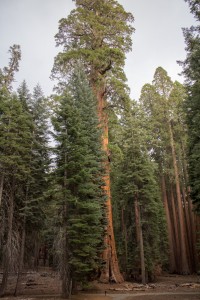“Between the heavy pine and silver fir zones towers the Big Tree (Sequoia gigantea), the king of all the conifers in the world, ‘the noblest of the noble race.'” —John Muir (Read Chapter 7 of The Yosemite for more from Muir on the sequoias in the Giant Forest and nearby locales.)
On June 10, 2013, I arrived with my partner John at Sequoia & Kings Canyon National Park (south of Yosemite National Park) with the intention of photographing, filming, and experiencing majestic ancient sequoia trees for my project Illuminating John Muir’s Yosemite (which could more accurately be called Illuminating John Muir’s Yosemite and Surrounding Relevant Areas!).

The Giant Forest (name coined by John Muir) is an exceptional stand of giant sequoias and other conifer trees. We entered the Forest in the late afternoon after a 4 or 5-hour drive from the Bay Area, where we had ended a several-day cross-country train trip from New York on Amtrak’s Lake Shore Limited and California Zephyr.
Driving southeast through the dry San Joaquin Valley—where we saw endless, rolling fields of golden-brown dried grass, irrigated almond farms, ranches, and small highway-side farm towns—we climbed winding Route 180 up and up into the pine-covered mountains, entering into Kings Canyon National Park. Heading further south into Sequoia National Park, we stopped at the Lodgepole Visitor Center to acquire trail maps and refill our water bottles, then made our way to our eventual destination at an elevation of roughly 6,400 feet.
We meandered down from the moderately busy parking lot to the General Sherman Tree, the world’s largest living tree by volume, then walked a fairly short loop on the paved Congress Trail, where the number of fellow tourists rapidly decreased.
The giant sequoia’s broad trunks were more massive and ancient (they can live over 3,000 years, third oldest in the world) than I could comprehend. Snapping photos and attempting vainly to capture the sheer size of the trees in my viewfinder, I spotted a number of deer, squirrels, butterflies and ants (all of which John Muir loved) and enjoyed the fern-dotted slopes of exposed soil coated in beds of dried pine needles. Peeking through branches, pine-covered rolling hills hovered in the distance, hazy and blue.
The light was a bit difficult for shooting this evening: slightly overcast and flat, with brief, beautiful moments of golden light breaking through. Once the sun was too low to continue, we drove back to our room at Stony Creek Lodge for a modest dinner of vacuum-sealed grocery store sandwiches (the only readily available food at that hour!) and rested up for our first full day in the Sierra Nevada.
Read the next post in the series (Day 2)
Return to the On the Road to Capture John Muir’s Yosemite to view the other entries in this series.